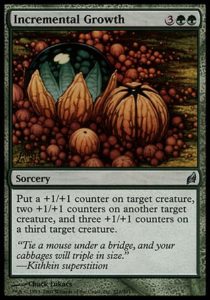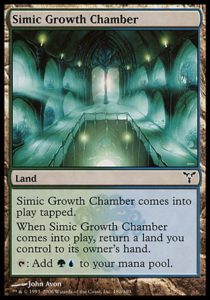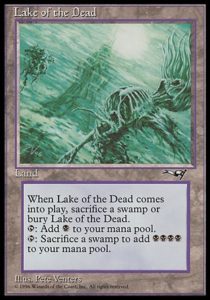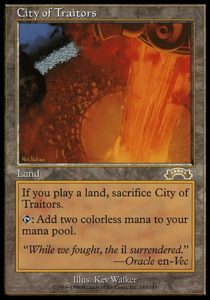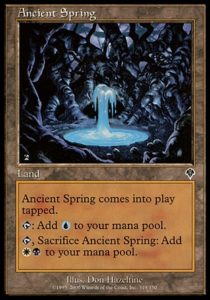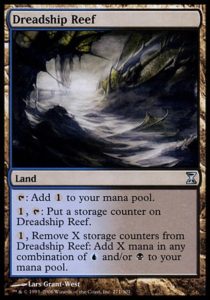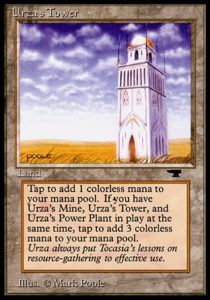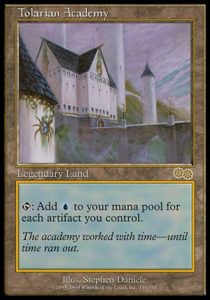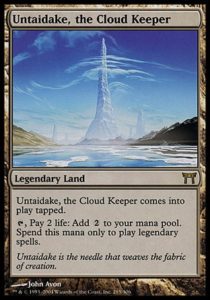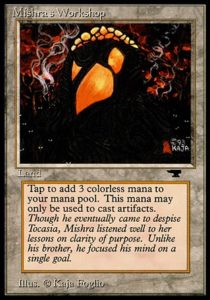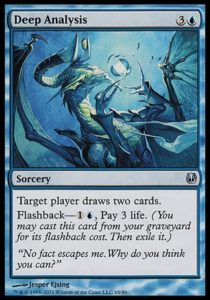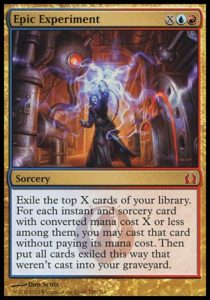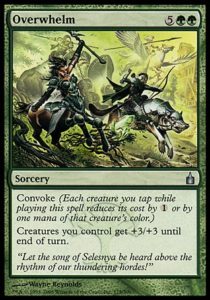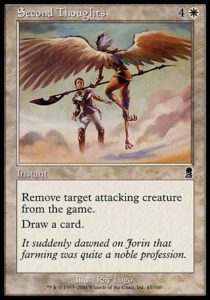This past weekend, we saw the immense power of [casthaven]Eye of Ugin[/casthaven] and [casthaven]Eldrazi Temple[/casthaven], two lands that produce more than one mana. We also saw [casthaven]Darksteel Citadel[/casthaven], a land which can produce multiple mana when a player has cards with affinity for artifacts. These are obviously strong Magic cards, but let’s consider what came before.
What are the rules and restrictions for lands which produce more than one mana? How do [casthaven]Eldrazi Temple[/casthaven] and [casthaven]Eye of Ugin[/casthaven] compare to them?
There’s a pretty strict rule in Magic: you can’t have more mana than the turn’s number. In other words, on turn 3, you’ll have 3 mana or less mana. Now, like most rules, this one is easily broken; there are mana rocks like [casthaven]Mind Stone[/casthaven], ramp spells like [casthaven]Rampant Growth[/casthaven], and mana-producing creatures like [casthaven]Elvish Mystic[/casthaven] that all produce extra mana.
In all these cases, you’re putting a spell into your deck to accelerate your mana and break the rule. However, relatively few lands violate this rule all by themselves. Lands have a pair of restrictions: you can only play one land a turn and each land taps for one mana. Let’s consider all of these rule-violating lands. I’ve categorized all of these lands by their restrictions. They’re not gospel, but they should work well enough.
Tempo loss—lands that you lose time by playing. These lands tend to offset the acceleration they provide by decelerating you just as much.
- [casthaven]Teferi’s Isle[/casthaven]. It enters the battlefield tapped, then phases out the next turn. You have to wait two turns to get its benefit, and then you only get it every other turn.
- The original [casthaven]Karoo[/casthaven] lands and the Ravnica bouncelands, such as [casthaven]Simic Growth Chamber[/casthaven]. They enter the battlefield tapped and bounce another land, negating any ramp they’d do (barring shenanigans like [casthaven]Voyaging Satyr[/casthaven] and [casthaven]Amulet of Vigor[/casthaven]). I won’t mention this kind of shenanigan again, so it applies to almost every land that taps for multiple mana.
Resource loss—lands that you must spend resources to play.
- [casthaven]Lotus Vale[/casthaven]. You have to lose two lands (and because you do, you’re not accelerating your mana production or breaking the one mana per turn rule).
- [casthaven]Lake of the Dead[/casthaven]. Our first land that actually ramps, but you need to lose two swamps for that first acceleration (requiring you to wait until at least turn 3 to benefit from it).
- [casthaven]Phyrexian Tower[/casthaven]. You can turn a creature into an additional mana. It’s a powerful trade-off, but not the easiest one to use (particularly since it only taps for colorless mana otherwise).
- [casthaven]Scorched Ruins[/casthaven]. It’s our second land that actually ramps you, but only by one mana and all of it is colorless (which was a strict disadvantage until the advent of colorless mana).
- [casthaven]Ancient Tomb[/casthaven]. It allows you to turn two life into an extra mana. That’s an amazing rate. Unsurprisingly, it’s the strongest land we’ve discussed so far (and will for a while). It’s insanely strong in decks such as Vintage Shops and Legacy Sneak and Show (not to mention a first-pickable cube card in pretty much any cube).
Limited Use—lands that don’t work forever.
- [casthaven]City of Traitors[/casthaven]. It technically doesn’t have to be destroyed, but then you’re not accelerating anymore. That belies its high power level; it’s almost always played alongside Ancient Tomb and does much of the same work, at a different cost.
Limited Use + Tempo Loss—lands that enter the battlefield tapped and only accelerate a few times before being destroyed.
- [casthaven]Ebon Stronghold[/casthaven] and its sacrifice cycle.
- [casthaven]Ancient Spring[/casthaven] and its sacrifice cycle.
- [casthaven]Saprazzan Skerry[/casthaven] and its depletion cycle. These lands are all quite similar and none are Modern legal. To the best of my knowledge, none of these are legacy playable (tempo loss is a huge downside), but some have seen heavy play in Pauper.
Time and mana investment—lands which require you to invest mana in them over a series of turns for them to function. These are all ‘storage lands.’
- [casthaven]Mage-Ring Network[/casthaven]. It recently saw play in some Standard control decks.
- [casthaven]Crucible of the Spirit Dragon[/casthaven]. It also has a type restriction (which I’ll talk about soon).
- [casthaven]Subterranean Hangar[/casthaven] and its storage cycle
- [casthaven]Hollow Trees[/casthaven] and its storage cycle
- [casthaven]Fungal Reaches[/casthaven] and its storage cycle. These can be quite strong
Land Restriction—lands which only function/accelerate when you have a certain number of lands in play.
- [casthaven]Temple of the False God[/casthaven]. An EDH favorite, but awkward for its inability to produce mana until the mid-stages of the game.
- [casthaven]Shrine of the Forsaken Gods[/casthaven]. A Standard powerhouse. Its heavy land requirement and type restriction (which I’ll talk about shortly) is indicative of just how powerful R&D considers such lands.
- [casthaven]Cabal Coffers[/casthaven]. Once you have four swamps (or this + [casthaven]Urborg, Tomb of Yawgmoth[/casthaven], and two other lands), this ramps. Otherwise, it does nothing. It’s strong, but the setup cost is comparable to [casthaven]Temple of the False God[/casthaven] and it’s even more restrictive on deckbuilding.
- [casthaven]Urza’s Tower[/casthaven], [casthaven]Urza’s Mine[/casthaven], and [casthaven]Urza’s Power Plant[/casthaven] (aka the Urzatron, or Tron for short). Assembling Tron has become significantly easier with the printing of cards like [casthaven]Sylvan Scrying[/casthaven], [casthaven]Expedition Map[/casthaven], and [casthaven]Ancient Stirrings[/casthaven], as well as powerful colorless spells to accelerate into, such as [casthaven]Karn Liberated[/casthaven] and [casthaven]Ulamog, the Ceaseless Hunger[/casthaven]. Tron is one of the premier Modern decks, despite the heavy deckbuilding and color restrictions.
- [casthaven]Cloudpost[/casthaven]. It’s a one card combo (along with [casthaven]Glimmerpost[/casthaven] and [casthaven]Vesuva[/casthaven]); it’s essentially Tron where you only need to assemble two pieces to get Power Plant/Mine online and where each subsequent land upgrades all of your [casthaven]Cloudpost[/casthaven]s. It’s strong enough to be banned in Modern.
Resource Reliance—lands which require you to have (but not spend) another resource in order for them to work. These include some incredibly strong lands.
- [casthaven]Tolarian Academy[/casthaven]. One of the most powerful lands in Magic. It’s restricted in Vintage (where it gets to combine with moxen) and banned everyone else, which should tell you something.
- [casthaven]Gaea’s Cradle[/casthaven]. Another incredibly strong land. This combines with creatures, which are slower to play than artifacts, but it’s still a powerhouse in Legacy Elves.
- [casthaven]Serra’s Sanctum[/casthaven]. Enchantments are harder to get into play quickly than artifacts or creatures, but I’d never expect it to be Modern legal.
- [casthaven]Nykthos, Shrine to Nyx[/casthaven]. It was the best land in Standard and has seen some fringe play in Modern, notably in the budget monogreen ramp deck.
Type Restriction + Tempo loss—lands that enter the battlefield tapped and whose mana can only be used in a specific way (I told you type restriction was coming soon). As far as I can recall, there’s only one such card.
- [casthaven]Untaidake, the Cloud Keeper[/casthaven]. And it’s awful. Untaidake has a tempo loss, produces only colorless mana, loses you life, and its mana can only be used for legendary creatures. Untaidake having so many restrictions is indicative of how careful R&D can be when creating lands which produce multiple mana, though it’s an example of a card so thoroughly underpowered, that it’s essentially unplayabale outside of EDH and the Legendary Cube.
Type Restriction—lands which only accelerate your mana if you’re using it in a specific way. If a deck can be built to contain mostly or only cards of that type, then the lands have no restriction other than the deckbuilding constraints.
- [casthaven]Eldrazi Temple[/casthaven]. The new scourge of Modern. Eldrazi Temple is notable in that it has no tempo loss and produces colorless mana normally, so it can go in a deck that’s not 100% Eldrazi (as seen in Modern Masters). Now that an all-Eldrazi deck is possible, [casthaven]Eldrazi Temple[/casthaven] is essentially [casthaven]Ancient Tomb[/casthaven] with no downside (other than the deckbuilding restriction). It’s worth noting that until Battle for Zendikar, the cheapest Eldrazi the temple could ramp out cost 7 mana (making Eldrazi Temple quite similar to [casthaven]Shrine of the Forsaken Gods[/casthaven]. The advent of the colorless mana symbol and devoid creatures changed everything.
- [casthaven]Eye of Ugin[/casthaven]. It’s already been a fixture of Modern for years, thanks to Tron. With the Rise of the (Devoid) Eldrazi and colorless mana symbol, it’s become an [casthaven]Ancient Tomb[/casthaven] for all your spells at the same time. It also interacts with [casthaven]Urborg, Tomb of Yawgmoth[/casthaven] to become [casthaven]Mishra’s Workshop[/casthaven]. Speaking of which…
- [casthaven]Mishra’s Workshop[/casthaven]. It is, without a doubt, one of the most powerful lands in Magic. Making three mana on turn one is the stuff of [casthaven]Black Lotus[/casthaven]. [casthaven]Mishra’s Workshop[/casthaven] does that every turn. It’s in one of the strongest Vintage decks and banned in Legacy.
There you have it. My classifications of (hopefully) all types of (hopefully) all lands which produce multiple mana. I’ve excluded [casthaven]Gemstone Caverns[/casthaven] (which essentially lets you turn being on the draw to being on the play), [casthaven]Urborg, Tomb of Yawgmoth[/casthaven], and [casthaven]Vesuva[/casthaven] since they don’t produce multiple mana (but can when combined with lands on this list). I’ve also excluded artifact lands and basic lands, since they produce multiple mana where affinity is concerned (and it’d be both silly and false to say that Plains produces multiple mana on its own).
It’s interesting the types of restrictions which lead to the most powerful lands. Some involve an imbalanced resource conversion, like [casthaven]Ancient Tomb[/casthaven] (two life is absolutely worth an extra mana), others rely on a resource strong enough to easily build a deck around, such as [casthaven]Tolarian Academy[/casthaven] and [casthaven]Mishra’s Workshop[/casthaven]. I can’t help but feel that the newly annointed [casthaven]Eldrazi Temple[/casthaven] and [casthaven]Eye of Ugin[/casthaven] are closer to the aforementioned than they are to [casthaven]Urza’s Tower[/casthaven] or [casthaven]Cloudpost[/casthaven]; by themselves, with nothing other than deckbuilding restrictions, they produce two (or more) mana. Even [casthaven]Cloudpost[/casthaven] mandates that you have a second (specific) land in play, but [casthaven]Eldrazi Temple[/casthaven] plays [casthaven]Eldrazi Mimic[/casthaven] or a 2/2 [casthaven]Endless One[/casthaven] on turn one with no problem. It just goes to show that if a certain type of card is powerful enough, having a land be restricted to producing 2+ mana of that type (and that being the land’s only restriction) isn’t a sufficient downside. Wizards makes very, very few lands of this sort and I’d scrutinize any future lands that play in this vein.
I don’t believe that [casthaven]Eldrazi Temple[/casthaven] or [casthaven]Eye of Ugin[/casthaven] were mistakes or bad designs. They didn’t have any low- or middle-cost Eldrazi to accelerate out back in 2010, and they got people excited about the Eldrazi. Moreover, I don’t believe that devoid or the colorless mana symbol were mistakes; they’re interesting design veins that tell a good story and are balanced for Standard, which is the only Constructed format R&D tests. Standard and Limited aren’t and shouldn’t be enslaved to sets which came before; that’s what banned lists are for. If a card is banned in Standard, R&D has made a big mistake, but if a card is banned in Modern, Legacy, or Vintage, well, that’s just what happens when you have an enormous card pool.
I believe that [casthaven]Eldrazi Temple[/casthaven] is too good for Modern (with Battle for Zendikar and Oath of the Gatewatch it’s become [casthaven]Ancient Tomb[/casthaven] with no downside), as is [casthaven]Eye of Ugin[/casthaven] (which was already a major role-player in Tron). I expect both cards to be banned, particularly if they put up good numbers at the next Modern GP weekend. In the absence of cards like [casthaven]Stifle[/casthaven], [casthaven]Wasteland[/casthaven], [casthaven]Force of Will[/casthaven], and dedicated hosers, I have no idea how Modern decks can fight them, other than by playing a version of Eldrazi designed to break the mirror (or perhaps [casthaven]Painter’s Servant[/casthaven] is a stronger hoser than it appears). And no, I don’t believe that [casthaven]Splinter Twin[/casthaven] would be able to fight the Eldrazi, even if it were legal.
Furthermore, I don’t believe that the existence of Modern Eldrazi is evidence that having a Modern Pro Tour is a mistake; this deck was going to happen. People were playing around with Eldrazi ever since BfZ came out (and the deck was already impressive then). Grand Prix have enough on the line to justify pros working to break Modern. The PT just means the deck shows up (and perhaps gets banned) now, rather than after a season of increasingly Eldrazi dominated GPs. At least, that’s my prediction.
I won’t be playing Modern again until either Eldrazi is banned, some dedicated, catch-all hoser appears (though I’m not even sure what such a thing would look like), or I’m proven wrong about the power and unstoppability of the Eldrazi menace. I was already wary of Eldrazi before it dominated the Pro Tour, but now I’m sure there’s nothing better to play than it. That said, I don’t want to buy into a deck I believe will get banned, and I don’t want to play a format which seems to have a de facto best deck with few to no bad matchups.
But that’s just my opinion. I love Modern, I love how R&D takes risks, and I love that new cards (which seem to be perfectly balanced in Standard) get a chance to shine in nonrotating formats. Perhaps we’ll even see Legacy Eldrazi with [casthaven]Eye of Ugin[/casthaven], [casthaven]Eldrazi Temple[/casthaven], [casthaven]Ancient Tomb[/casthaven], and [casthaven]City of Traitors[/casthaven]. Only time will tell. All I know is we’re living in exciting times.
And, as always, thanks for reading.
—Zachary Barash
Zachary Barash has been playing Magic on and off since 1994. He loves Limited and drafts every available format (including several that aren’t entirely meant to be drafted). He’s a proud Cube owner, improviser, and game designer (currently going for an MFA in Game Design at NYU). He has an obsession with Indian food that borders on being unhealthy.

